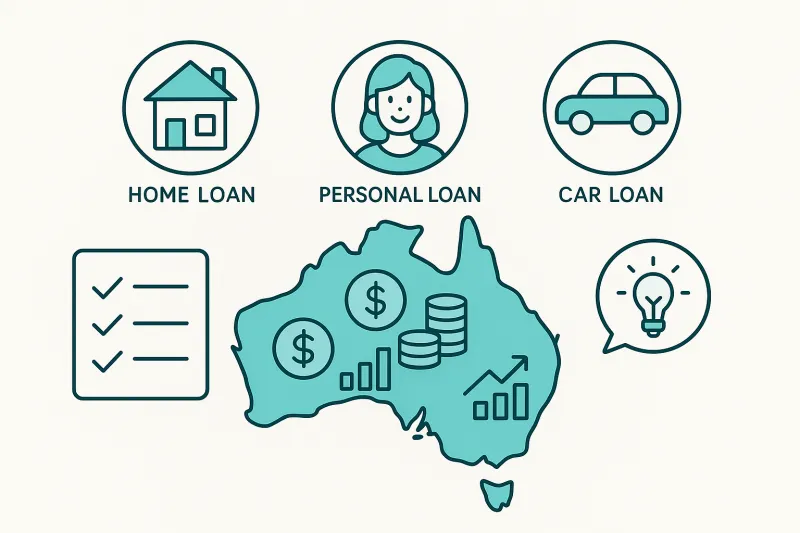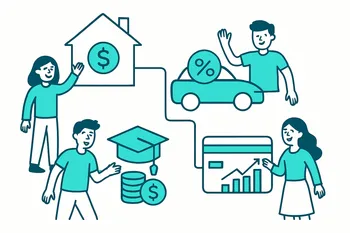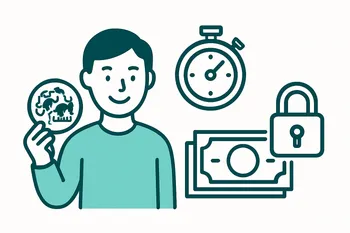Understanding Loans: A Comprehensive Guide for Australians
- Personal Finance
- 03 Mins read

Understanding Loans: A Comprehensive Guide for Australians
What Are Loans and How Do They Work?
Loans are borrowed sums of money that you agree to pay back with interest over time. In Australia, loans come in many shapes and sizes, from small personal loans to hefty mortgages. Each type has its own terms and conditions.
The key idea here is interest. Interest is the cost of borrowing money, usually expressed as a percentage of the loan. If you borrow $10,000 at an interest rate of 5%, you'll have to pay back the $10,000 plus $500 in interest.
Types of Loans Available in Australia
When it comes to loans, one size does not fit all. Here's a breakdown of the main types you'll encounter:
Personal Loans: Useful for many purposes like holidays or wedding expenses. They can be secured (tied to an asset) or unsecured (no collateral needed).
Home Loans (Mortgages): Specifically for purchasing property. Interest rates and fees can significantly vary, so shop around.
Car Loans: Specifically for buying a vehicle, often with competitive interest rates.
Student Loans: For education expenses, generally under the HECS-HELP system. These are a bit different as they're paid back through the tax system once you earn above a certain amount.
Business Loans: Designed for new ventures or expanding a business. Terms can vary widely based on business health.
How to Choose the Right Loan
Step 1: Identify Your Needs
Before you apply, consider what you need the money for. This seems basic, but aligning your purpose with the right loan type is crucial.
Step 2: Compare Interest Rates
Use tools like the RBA website or financial comparison sites to check current interest rates. Even a small difference in rates can save you thousands over time.
Step 3: Know the Terms
Loan terms dictate the timeline of repayment and include the interest rate, repayment schedule, and potential fees. Always read the fine print.
“In my ten years as a mortgage broker, understanding the true cost of a loan has been the most overlooked step by borrowers.” – Nathan Smith
Step 4: Consider the Repayment Schedule
A loan with a short repayment period will cost less in interest but will have higher monthly payments. A longer period means lower payments but more interest over the life of the loan.
Interest Rates and How They Impact Your Loan
Interest rates are determined by market conditions and set by lenders. They indicate the cost of borrowing. Here’s a simple illustration:
Imagine a home loan of $500,000 with an interest rate of 4%. Over 30 years, interest payments alone could add up to over $350,000. But if you secure a rate of 3.5%, you'd pay $50,000 less in interest, illustrating how even small rate differences matter.
Understanding Compound Interest
Compound interest is when interest adds to your principal amount so every subsequent interest calculation is on a larger balance. For example, a $1,000 loan at 5% annual interest will owe $1,050 after one year. In year two, interest is on $1,050.
Key Point: Always look for the term “compounding frequency” in loan offers. The more frequently the interest is compounded, the more you'll pay overall.
Avoiding Common Pitfalls
From my experience, here’s what to watch for:
Hidden Fees: Application fees, late payment penalties, and early repayment penalties can cost you. Always ask the lender for a full list of fees.
Long Approval Times: Some loans take weeks to approve. If you need money fast, this could be a problem.
Unrealistic Repayment Plans: Ensure you can make the payments comfortably. A sudden interest rate change or financial hiccup shouldn't derail your budget.
Tips for Getting the Best Loan Terms
Improve Your Credit Score: A higher score can unlock better terms. Regularly check your score and resolve any discrepancies.
Negotiate: Many borrowers don’t realize interest rates can be negotiated. Don’t be shy—talk to your lender.
Pre-approval: Getting pre-approved can give you a better idea of what you're eligible for, making the process smoother.
Use Reputable Lenders: Stick with lenders that have a strong presence in Australia and good customer reviews.
Case Study: First-Home Buyer Dilemma
Let’s take Sarah, a first-home buyer in Melbourne. She was overwhelmed by mortgage options. After seeking advice, she made a list of priorities: low-interest rate, flexible repayment terms, and no hidden fees. By comparing offers from several banks, she secured a rate that saved her thousands over the loan's life.
Final Thoughts
Navigating the world of loans in Australia doesn’t have to be daunting. With the right knowledge and tools, you can make informed decisions. Always ask questions, seek clarity, and don’t rush the process. Remember, the best loan is one that meets your needs without stretching your finances thin.



